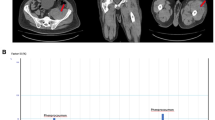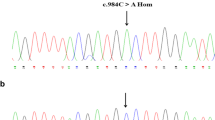Summary
Bleeding complications represent the most common and unwanted side effect of oral anticoagulant therapy. We present a novel mechanism for bleeding during coumarin therapy, attributed to newly described missense mutations in the factor IX propeptides of three patients. Strikingly, bleeding occurred at therapeutic ranges of prothrombin time (PT) and international normalized ratio (INR). In all three patients, coumarin therapy caused an unusually selective decrease of factor IX activity (below levels of 1%–3%). Upon withdrawal of coumarin, factor IX activity increased to subnormal or normal values of 48%, 83% and 125%, respectively. Analysis of the factor IX gene revealed two different missense mutations affecting the Ala-io residue in the propeptide coding region: Ala[GCC] to Val[GTC] in two patients and Ala[GCC] to Thr[ACC] in one patient. Screening 115 random blood donors for mutations at Ala-10, no further mutation could be detected, thus excluding a frequent polymorphism at this position. The mutation in the factor IX propeptide at a position, which is essential for the carboxylase recognition site, probably causes a reduced affinity of the carboxylase enzyme to the propeptide. This effect leads to an impaired carboxylase epoxidase reaction that is decisively triggered by the vitamin K concentration. As a clinical consequence of our findings, determination of Factor IX and APTT additionally to PT and INR is recommended in coumarin-treated patients with an uncommon bleeding pattern.
Preview
Unable to display preview. Download preview PDF.
Similar content being viewed by others
References
Hull R, Hirsh J, Jay R, Carter C, England C, Gent M, Turpie AGG, McLoughlin D, Dodd P, Thomas T, Raskob G, Ockelford P (1982) Different intensities of oral anticoagulant therapy in the treatment of proximal-vein thrombosis. N Engl J Med 307: 1676–1681
Saour JN, Sieck JO, Mamo LAR, Gallus AS (1990) Trail of different intensities of anticoagulation in patients with prosthetic heart valves. N Engl J Med 322: 428–432
Poller L, Taberner DA (1982) Dosage and control of oral anticoagulants: an international collaborative survey. Br J Haem 51: 479–485
Biggs R, Denson KWE (1963) The Fate of Prothrombin and Factors VII, IX and X Transfused to Patients Deficient in these Factors. Br J Haematol 9: 532–547
Hoffman GC, Hewlett JS (1965) Exchange transfusion in hereditary factor VII (proconvertin) deficiency. Am J Clin Pathol 44: 198–202
Loelieger EA, Hensen A (1961) Substitution therapy in haemophilia B. Thromb Diathes Haemorrh 6: 391–410
Roberts HR, Lechler E, Webster WP, Penick GD (1965) Survival of transfused factor X in patients with Stuart disease. Thromb Diathes Haemorrh 13: 305–313
Hirsh J (1991) Oral anticoagulant drugs. N Engl J Med 324: 1865–1875
Fasco MJ, Hildebrandt EF, Suttie JW (1982) Evidence that warfarin anticoagulant action involves two distinct reductase activities. J Biol Chem 257: 11210–11212
Willingham AK, Matschiner JT (1974) Changes in phylloquinone epoxidase activity related to prothrombin synthesis and microsomal clotting activity in the rat. Biochem J 140: 435–441
Jorgensen MJ, Cantor AB, Furie BC, Brown CL, Shoemaker CB, Furie B (1987) Recognition site directing vitamin K-dependent gamma-carboxylation resides on the propeptide of factor IX. Cell 48: 185–191
Foster IC, Rudinski MS, Schach BG et al (1987) Propeptide of protein C is necessary for y-carboxylation. Biochemistry 26: 7003–7011
Huber P, Schmitz T, Griffin J, Jacobs M, Walsh C, Furie B, Furie BC (1990) Identification of amino acids in the y-carboxylation recognition site on the propeptide of prothrombin. J Biol Chem 265: 12 467–12 473
Sanford DG, Kanagy C, Sudmeier JL, Furie BC, Furie B, Bachovchin WW (1991) Structure of the propeptide of prothrombin containing the y-carboxylation recognition site determined by two-dimensional NMR spectroscopy. Biochemistry 30: 9835–9841
Biggs R, Macfarlane MG (1957) Human blood coagulation and its disorders. Oxford University Press, Oxford
Ludwig M, Grimm T, Brackmann HH, Olek K (1992) Parental origin of factor IX gene mutations and their distribution in the gene. Am J Hum Genet 50: 164–173
Orita M, Iwahana H, Kanazawa H, Hayashi K, Sekiya T (1989) Detection of polymorphisms of human DNA by gel electrophoresis as single-strand conformation polymorphism. Proc Natl Acad Sci USA 86: 2766–2770
Kumar S, Haigh JRM, Tate G et al (1990) Effect of warfarin on plasma concentrations of vitamin K-dependent coagulation factors in patients with stable control and monitored compliance. Br J Haematol 74: 82–85
Weiss P, Soff GA, Molkin H, Seligsohn U (1987) Decline of proteins C and S and factors II, VII, IX and X during the initiation of warfarin therapy. Thromb Res 45: 783–790
Cooper DN, Youssouffian H (1988) The CpG dinucleotide and human genetic disease. Hum Genet 78: 151–155
Gianelli F, Green PM, Sommer SS et al (1996) Haemophilia B (sixth edition): a database of point mutations and short additions and deletions. Nucleic Acids Res 24: 103–118
Hubbard BR, Ulrich MW, Jacobs M, Vermeer C, Walsh C, Furie B, Furie BC (1989) Vitamin K-dependent carboxylase: affinity purification from bovine liver by using a synthetic pro-peptide containing the y-carboxylation recognition site. Proc Natl Acad Sci USA 86: 6893–6897
Soute BAM, Ulrich MMW, Watson DJ, Maddison JE, Ebberink RHM, Vermeer C (1987) Congenital deficiency of all vitamin K-dependent blood coagulation factors due to a defective vitamin K-dependent carboxylase in devon rex cats. Thromb Haemost 57: 521–525
Editor information
Editors and Affiliations
Rights and permissions
Copyright information
© 1998 Springer-Verlag Berlin Heidelberg
About this paper
Cite this paper
Oldenburg, J. et al. (1998). Missense Mutations at ALA-10 in the Factor IX Propeptide: A Novel Mechanism for Severe Bleeding During Oral Anticoagulant Therapy. In: Scharrer, I., Schramm, W. (eds) 27. Hämophilie-Symposion Hamburg 1996. Springer, Berlin, Heidelberg. https://doi.org/10.1007/978-3-642-80403-8_43
Download citation
DOI: https://doi.org/10.1007/978-3-642-80403-8_43
Publisher Name: Springer, Berlin, Heidelberg
Print ISBN: 978-3-540-62915-3
Online ISBN: 978-3-642-80403-8
eBook Packages: Springer Book Archive




